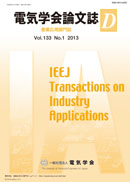Volume 133, Issue 9
Displaying 1-25 of 25 articles from this issue
- |<
- <
- 1
- >
- >|
Paper
-
2013Volume 133Issue 9 Pages 861-867
Published: September 01, 2013
Released on J-STAGE: September 01, 2013
Download PDF (1270K) -
2013Volume 133Issue 9 Pages 868-875
Published: September 01, 2013
Released on J-STAGE: September 01, 2013
Download PDF (2009K) -
2013Volume 133Issue 9 Pages 876-884
Published: September 01, 2013
Released on J-STAGE: September 01, 2013
Download PDF (3539K) -
2013Volume 133Issue 9 Pages 885-893
Published: September 01, 2013
Released on J-STAGE: September 01, 2013
Download PDF (2497K) -
2013Volume 133Issue 9 Pages 894-901
Published: September 01, 2013
Released on J-STAGE: September 01, 2013
Download PDF (1888K) -
2013Volume 133Issue 9 Pages 902-908
Published: September 01, 2013
Released on J-STAGE: September 01, 2013
Download PDF (2475K) -
2013Volume 133Issue 9 Pages 909-916
Published: September 01, 2013
Released on J-STAGE: September 01, 2013
Download PDF (2124K) -
2013Volume 133Issue 9 Pages 917-927
Published: September 01, 2013
Released on J-STAGE: September 01, 2013
Download PDF (2495K) -
2013Volume 133Issue 9 Pages 928-935
Published: September 01, 2013
Released on J-STAGE: September 01, 2013
Download PDF (2193K) -
2013Volume 133Issue 9 Pages 936-942
Published: September 01, 2013
Released on J-STAGE: September 01, 2013
Download PDF (4951K) -
2013Volume 133Issue 9 Pages 943-951
Published: September 01, 2013
Released on J-STAGE: September 01, 2013
Download PDF (2449K)
Letter
-
2013Volume 133Issue 9 Pages 952-953
Published: September 01, 2013
Released on J-STAGE: September 01, 2013
Download PDF (1555K)
-
2013Volume 133Issue 9 Pages ES9_1-ES9_11
Published: September 01, 2013
Released on J-STAGE: September 01, 2013
Download PDF (3501K)
News Letter
-
2013Volume 133Issue 9 Pages NL9_1
Published: September 01, 2013
Released on J-STAGE: September 01, 2013
Download PDF (476K) -
2013Volume 133Issue 9 Pages NL9_2-NL9_7
Published: September 01, 2013
Released on J-STAGE: September 01, 2013
Download PDF (1508K) -
2013Volume 133Issue 9 Pages NL9_8-NL9_9
Published: September 01, 2013
Released on J-STAGE: September 01, 2013
Download PDF (9348K) -
2013Volume 133Issue 9 Pages NL9_10
Published: September 01, 2013
Released on J-STAGE: September 01, 2013
Download PDF (657K) -
2013Volume 133Issue 9 Pages NL9_11
Published: September 01, 2013
Released on J-STAGE: September 01, 2013
Download PDF (697K) -
2013Volume 133Issue 9 Pages NL9_12
Published: September 01, 2013
Released on J-STAGE: September 01, 2013
Download PDF (526K) -
2013Volume 133Issue 9 Pages NL9_13
Published: September 01, 2013
Released on J-STAGE: September 01, 2013
Download PDF (397K) -
2013Volume 133Issue 9 Pages NL9_14
Published: September 01, 2013
Released on J-STAGE: September 01, 2013
Download PDF (495K) -
2013Volume 133Issue 9 Pages NL9_15
Published: September 01, 2013
Released on J-STAGE: September 01, 2013
Download PDF (408K) -
2013Volume 133Issue 9 Pages NL9_16
Published: September 01, 2013
Released on J-STAGE: September 01, 2013
Download PDF (539K) -
2013Volume 133Issue 9 Pages NL9_17-NL9_18
Published: September 01, 2013
Released on J-STAGE: September 01, 2013
Download PDF (400K) -
2013Volume 133Issue 9 Pages NL9_19-NL9_20
Published: September 01, 2013
Released on J-STAGE: September 01, 2013
Download PDF (408K)
- |<
- <
- 1
- >
- >|
